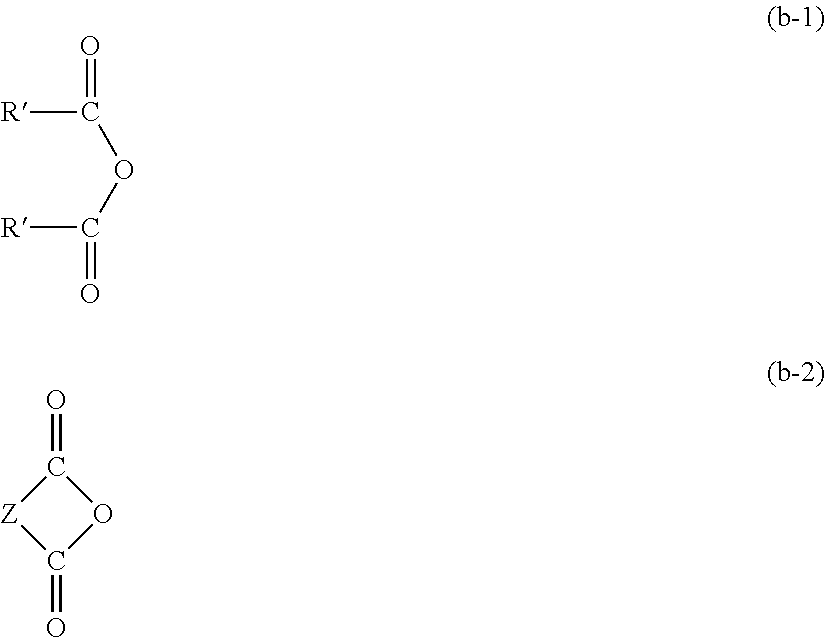Method for producing thioester group-containing organosilicon compound, thioester group-containing organosilicon compound, compounding agent for rubber, rubber composition, and tire
a technology of organosilicon and thioester group, which is applied in the field of producing organosilicon compound, thioester group-containing organosilicon compound, compounding agent for rubber, rubber composition, tire, etc., can solve the problem of low workability, need of multiple-step kneading and low workability, and the rubber composition of tire which has realized the desired low fuel consumption has not yet been realized. achieves the desired low fuel consumption, reduce scorching
- Summary
- Abstract
- Description
- Claims
- Application Information
AI Technical Summary
Benefits of technology
Problems solved by technology
Method used
Image
Examples
example 1
[0070]A 1 L separable flask equipped with an agitator, a reflux condenser, a dropping funnel, and a thermometer was charged with 102.1 g (1.0 mol) of acetic anhydride, 1.0 g (0.01 mol) of N,N-dimethylaminopyridine, and 300 g of toluene, and the mixture was heated to 70° C. in an oil bath. To this mixture, 243.2 g (1.0 mol) of γ-mercaptopropyltriethoxysilane (KBE-803 manufactured by Shin-Etsu Chemical Co., Ltd.) was added dropwise, and then, the mixture was stirred for 2 hours by heating to 70° C. Reaction was completed after confirming the complete disappearance of the peak from the mercaptosilane of the starting material and appearance of the peak from the thioesterified moiety by GC. The reaction solution was distilled at reduced pressure to remove toluene and obtain a colorless transparent liquid (yield, 310.7 g). The thus obtained reaction product had a viscosity of 2.7 mm2 / s, a specific weight of 1.026, and a refractive index of 1.477. 1H NMR spectrum revealed that the reaction...
example 2
[0071]A 1 L separable flask equipped with an agitator, a reflux condenser, a dropping funnel, and a thermometer was charged with 270.4 g (1.0 mol) of octanoic anhydride, 1.0 g (0.01 mol) of N,N-dimethylaminopyridine, and 300 g of toluene, and the mixture was heated to 70° C. in an oil bath. To this mixture, 243.2 g (1.0 mol) of γ-mercaptopropyltriethoxysilane (KBE-803 manufactured by Shin-Etsu Chemical Co., Ltd.) was added dropwise, and then, the mixture was stirred for 2 hours by heating to 70° C. Reaction was completed after confirming the complete disappearance of the peak from the mercaptosilane of the starting material and appearance of the peak from the thioesterified moiety by GC. The reaction solution was distilled at reduced pressure to remove toluene and obtain a yellow transparent liquid (yield, 416.1 g). The thus obtained reaction product had a viscosity of 250.7 mm2 / s, a specific weight of 1.031, and a refractive index of 1.484. 1 H NMR spectrum revealed that the reacti...
example 3
[0072]A 1 L separable flask equipped with an agitator, a reflux condenser, a dropping funnel, and a thermometer was charged with 100.1 g (1.0 mol) of succinic anhydride, 1.0 g (0.01 mol) of N,N-dimethylaminopyridine, and 300 g of toluene, and the mixture was heated to 70° C. in an oil bath. To this mixture, 243.2 g (1.0 mol) of γ-mercaptopropyltriethoxysilane (KBE-803 manufactured by Shin-Etsu Chemical Co., Ltd.) was added dropwise, and then, the mixture was stirred for 2 hours by heating to 70° C. Reaction was completed after confirming the complete disappearance of the peak from the mercaptosilane of the starting material by GC. The reaction solution was distilled at reduced pressure to remove toluene and obtain a colorless transparent liquid (yield, 326.2 g). The thus obtained reaction product had a viscosity of 232 mm2 / s, a specific weight of 1.029, and a refractive index of 1.483. 1H NMR spectrum revealed that the reaction product was a mixture of the compounds represented by t...
PUM
| Property | Measurement | Unit |
|---|---|---|
| reaction temperature | aaaaa | aaaaa |
| reaction temperature | aaaaa | aaaaa |
| reaction temperature | aaaaa | aaaaa |
Abstract
Description
Claims
Application Information
 Login to View More
Login to View More - R&D
- Intellectual Property
- Life Sciences
- Materials
- Tech Scout
- Unparalleled Data Quality
- Higher Quality Content
- 60% Fewer Hallucinations
Browse by: Latest US Patents, China's latest patents, Technical Efficacy Thesaurus, Application Domain, Technology Topic, Popular Technical Reports.
© 2025 PatSnap. All rights reserved.Legal|Privacy policy|Modern Slavery Act Transparency Statement|Sitemap|About US| Contact US: help@patsnap.com



